I’m a couple of days late with Month Seven of the Big Fun Mystery Sew Along. With QuiltCon Together and various other things on the calendar, February sped by way too fast! But here we are now, with two block designs to add to your past month’s creations, as you, perhaps, begin to think about how you might bring them all together soon. Today we’re also sharing some of our initial inspiration images for this sew along so that you can get an idea of what motivates us as we develop each month’s instructions and themes.
We’ve titled this month “Logs and Bars.” There’s a simple variation on a log cabin and a block of offset strips that is constructed in a less-strip-y method than you might think. Once again, we hope these blocks allow for a wide amount of variation and play… and we can’t wait to see your versions of them.
Looking for past months’ instructions? Here are links to all of the “back issues”:
Share your work and your process on Facebook or Instagram with the hashtags #chicagomqgsewalong and #BFMSAL. And/or use them to follow along and see what others are creating.
MONTH 7 BLOCKS: Logs and Bars
This month we’re featuring a block with sliding “bars” that creates a fun undulating pattern when repeated and rotated, and a simple modern rectangular variation on a log cabin. The first could be used to create a wide border for a medallion; or a single border, row or block in a sampler quilt. The second can be scaled to whatever size you want for infill or impact, and could create a nice place for the eye to rest in a busy quilt top. We hope you’ll enjoy playing with Sliding Bars and City House this month!

Notes about Sliding Bars:
I had a lot of fun with this block, including puzzling out an efficient way to construct it without using a lot of tiny pieces. I think this would be really fun to scale up and use to make a giant quilt (or a baby quilt) with a bunch of rows of this undulating pattern. If you’re using a directional print for the foreground fabric, be aware that some of the strips will be flipped due to the construction method. I wasn’t concerned about this with the raindrops print I used, but you can see that the raindrops alternate direction in the outside strips. The instructions are for a single block, which is 5″x10″ finished. Make two for the 10″x10″ block shown above.
Sliding Bars cutting instructions:
From Main fabric: Cut (1) 5.5”x7.5″ rectangle
From Background fabric: Cut (1) 2.5″x7.5″ rectangle
Cut (1) 1.5″x3″ rectangle
Cut (1) 3.5″x5.5″ rectangle
Sliding Bars piecing instructions:
MAKE THE BLOCK:
1. Sew the Main fabric to the 2.5″x7.5″ Background piece along one 7.5″ edge. Press seam.

2. Trim across the seam to make one 4.5″ wide piece and one 3″ wide piece. Then trim the 4.5″ wide piece into three 1.5″ strips. Set these three strips aside.

3. Sew the 1.5″x3″ Background piece to the 3″ wide strip as shown. Press seam.
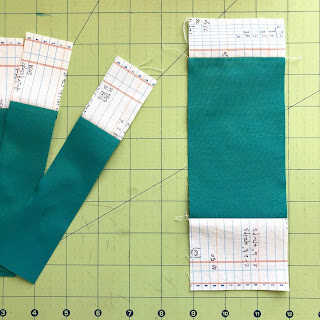
4. Trim 1″ from the end with the longer length of background fabric to create one 7.5″ length with equal amounts of background fabric at each end. Then trim into two 1.5″ strips.
5. Arrange the five finished strips as shown, and then sew together and press seams.
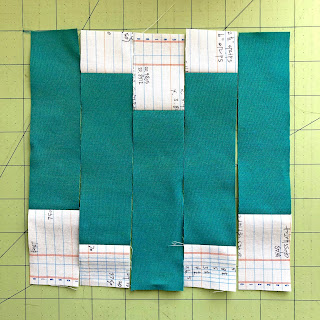
6. Sew the 3.5″x5.5″ piece to top 5.5″ edge as shown. Press seam. Block measures 5-1/2″x10-1/2″ unfinished.
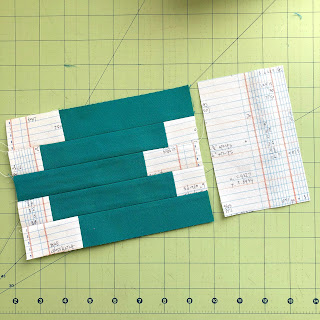
7. If desired, create another block following Steps 1-6, rotate 180 degrees, and then sew the two blocks together to continue the pattern of the undulating bars. Two blocks measure 10-1/2″ square unfinished.
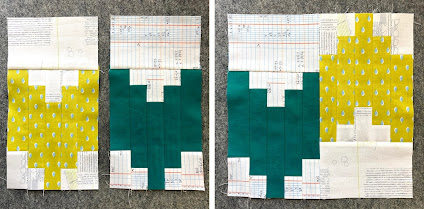
Notes about City House:
This is essentially an elongated log cabin block, although it’s constructed more like Courthouse Steps, and it has the overall look of a housetop quilt (thus the name). I generally see Log Cabins constructed in a spiral sequence, and Courthouse Steps blocks built out symmetrically with equal length strips added to opposite sides. When each border is a single color, I found that the block is sometimes called White House Steps or Cabin in the Cotton. I won’t pretend to be a quilt historian or expert, though, and there are so many nuances and varieties to all of these. So I will just say that this block is inspired by some of the most recognizable and classic blocks used in quilts.
You can follow the instructions below to make a 5″x8″ finished block with 1″ wide rounds. Or grab whatever strips you have on hand, in the same or in varying widths, to create your own unique version. To make a similarly proportioned rectangle, start with a center strip that is roughly 3-5 times as long as it is wide. Please note: the photos below show a block that finishes at 9″ long, instead of 8″, but I later changed the instructions to shorten it to 8″ and match similarly sized blocks from previous months, hopefully making the final quilt top construction a bit easier.
City House cutting instructions:
Cut 1.5″ wide strips in the following lengths:
From Color A: (1) 4.5” strip
From Color B: (2) 3.5″ strips
(2) 4.5″ strips
From Color C: (2) 5.5″ strips
(2) 6.5″ strips
City House piecing instructions:
MAKE THE BLOCK:
1. Sew one 4.5″ Color B strip to either side of the Color A strip. Press seams.

2. Sew one 3.5″ Color B strip to each 3.5″ side of your pieced section, and then press seams to create the first round.
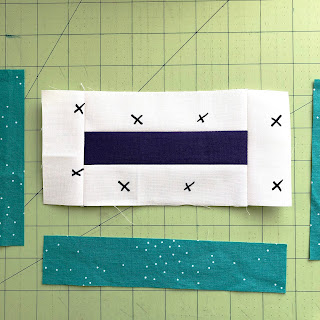
3. Sew one 6.5″ Color C strip to each 6.5″ side of your pieced section and press seams. Then sew one 5.5″ Color C strip to each 5.5″ side to complete a second round. Press seams. Blocks measure 5-1/2″x8-1/2″ unfinished.
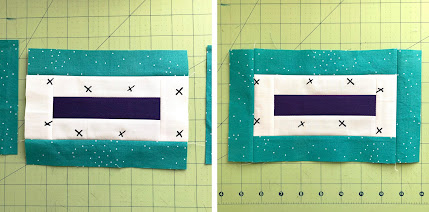
Variations: Vary the widths of your strips from round to round, or even within a round. Start with a square or a rectangular strip. Add as many or as few rounds as you wish. Alternate solids and prints. Make a two-color only version. If improvising, cut each strip as you go: attached strips to two sides, press, trim if needed, then measure the new width and cut two more strips to that size (or slightly longer). Keep pressing, trimming, and cutting in that manner until you decide that you’re finished.
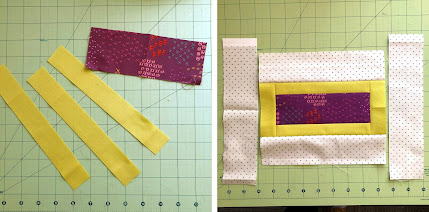
Inspiration behind the Big Fun Mystery Sew Along:
We love the bold, modern, and playful look of this quilt by Siobhon Rogers. Can you see the influence? Siobhon’s pattern for the quilt appeared in the August 2015 issue of the Australian version of Better Homes & Gardens magazine, so get your hands on that if you want to make this specific design. Check out @siobhonrogersco on Instagram to see more of her quilts and her fabulous-looking bakes.
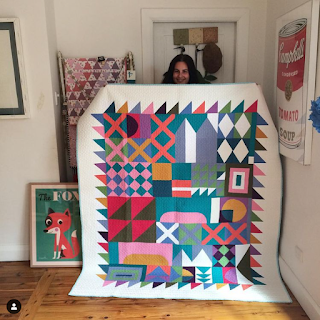
We were also inspired by the 1981 Quilt, by Nancy Purvis. Plus, ooooh that hand quilting!
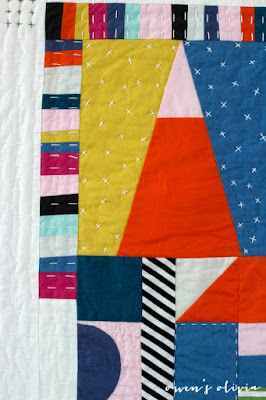
And this limited color improvisational quilt top by artist Lisa Congdon.

Please reach out to Amy or Bill with any questions. We hope you’re enjoying this process!
